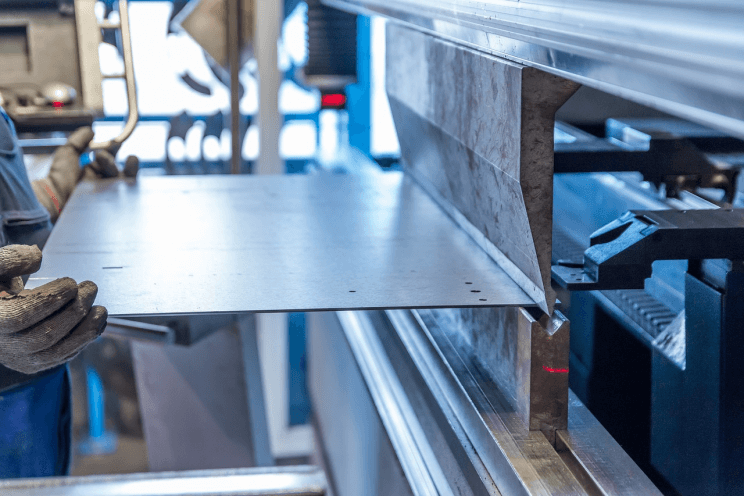
In an era defined by speed, precision, and customization, sheet metal fabrication continues to evolve rapidly. From automotive to aerospace and consumer electronics, prototyping with sheet metal enables engineers to test functionality, reduce costs, and bring products to market faster. As we move toward Industry 4.0, let’s explore the most impactful trends shaping the future of sheet metal prototyping.
For professional services and expert support in this field, visit Boona Prototypes’ Sheet Metal Fabrication Services to learn more.
I. Cutting & Forming Technology Advancements
1.1 Laser Cutting Innovations
High-speed fiber lasers now offer tighter tolerances and faster turnaround times than traditional CO₂ systems. They reduce thermal distortion, improve edge quality, and cut complex geometries efficiently.
| Technology | Tolerance | Cutting Speed | Max Thickness |
|---|---|---|---|
| Fiber Laser | ±0.05 mm | 20–50 mm/sec | Up to 25 mm (mild steel) |
| CO₂ Laser | ±0.1 mm | 10–30 mm/sec | Up to 15 mm (mild steel) |
1.2 CNC Press Brakes
Multi-axis CNC press brakes integrate with smart sensors and AR/VR for ultra-precise bending. They can adapt in real time based on material springback and tool wear.
II. Digital Transformation in Sheet Metal Prototyping
2.1 Automation & Robotics
Collaborative robots (cobots), automated guided vehicles (AGVs), and robotic welding arms are reducing human intervention and increasing consistency in sheet metal processes.
2.2 IoT Integration
Sensors embedded in production lines enable real-time monitoring, predictive maintenance, and digital twins. This streamlines the design–test–iteration loop for prototypes.
Example:
-
Boona Prototypes uses integrated CNC and laser platforms to support rapid prototyping with tight lead times and material traceability.
👉 Learn how Boona Prototypes implements advanced sheet metal solutions to power your prototyping pipeline.
III. 3D Metal Printing in Sheet Metal
While additive manufacturing was once reserved for plastics, metal 3D printing is becoming more mainstream. Techniques like selective laser melting (SLM) and binder jetting are being used to create hybrid components with complex internal structures.
| Process | Typical Materials | Layer Thickness | Surface Finish (as-built) |
|---|---|---|---|
| Binder Jetting | Stainless Steel, Inconel | 30–100 µm | Rough (Ra ~15 µm) |
| Selective Laser Melting | Aluminum, Titanium | 20–50 µm | Better (Ra ~10 µm) |
IV. Material Trends and Sustainability
Modern sheet metal fabrication is no longer just about aluminum or stainless steel. Advanced alloys, composites, and coated metals are improving performance while reducing weight.
Common Materials for Prototyping at Boona Prototypes:
| Material | Key Features | Applications |
|---|---|---|
| 6061 Aluminum | Lightweight, good corrosion resistance | Enclosures, panels, brackets |
| 304 Stainless | High strength, anti-corrosion | Medical, food-grade parts |
| SPCC Cold Rolled | Low cost, good formability | Automotive & appliance housings |
Visit Boona’s Sheet Metal Services Page for a detailed list of available materials and surface finishes.
V. Agile Prototyping and On-Demand Customization
Modern fabrication workflows prioritize speed-to-prototype. Platforms like Boona use DFM analysis (Design for Manufacturability) and digital quoting to help clients reduce iteration time.
Benefits of Agile Sheet Metal Prototyping:
-
Real-time quoting with CAD uploads
-
Same-day production for simple geometries
-
Online design review and remote collaboration
-
Small-batch runs without high setup costs
✅ Boona Prototypes offers low MOQ and fast turnaround options tailored for R&D and startup teams.
VI. Surface Finishing & Post-Processing
High-quality finishes are critical for both visual and functional validation in prototypes.
| Surface Treatment | Purpose | Typical Ra (Roughness) |
|---|---|---|
| Powder Coating | Aesthetic, corrosion-resistant | 2–5 µm |
| Bead Blasting | Matte finish, texture control | 3–10 µm |
| Anodizing | Surface hardening | 0.5–3 µm |
VII. Workforce and Digital Skill Development
As automation rises, there’s a growing need for digitally literate technicians and engineers. Tools like CAD–CAM integration, real-time production dashboards, and AR-assisted machines are now standard in future-ready shops like Boona.
Conclusion
The future of sheet metal prototyping is intelligent, fast, and sustainable. By embracing innovations in automation, digital design, and hybrid fabrication, companies can deliver better prototypes faster and at lower cost.
If you’re looking to modernize your prototyping pipeline, explore the cutting-edge services at
🔗 Boona Prototypes Sheet Metal Fabrication
FAQs
1. What is sheet metal fabrication, and why is it important in prototyping?
Sheet metal fabrication involves cutting, bending, and assembling flat metal sheets into functional components. In prototyping, it allows engineers to create realistic, testable versions of a product before moving to full production, helping to identify design flaws and optimize functionality.
2. How is laser cutting used in modern sheet metal prototyping?
Laser cutting is a precision process that uses focused laser beams to cut materials. Today’s fiber lasers offer improved accuracy, higher speeds, and the ability to cut thicker materials with minimal heat distortion—ideal for prototyping complex parts.
3. What are the benefits of CNC press brakes in rapid prototyping?
CNC press brakes use computer-controlled systems to bend sheet metal with extreme accuracy. They reduce manual error, increase repeatability, and allow for faster iterations during the prototype development phase.
4. How does 3D metal printing complement traditional sheet metal fabrication?
3D metal printing enables the creation of complex geometries and internal structures that are difficult or impossible to fabricate with traditional methods. When combined with CNC or laser-cut parts, it allows for hybrid prototypes that are both functional and cost-effective.
5. What role does sustainability play in the future of sheet metal prototyping?
Sustainability is becoming a core priority. Trends include using recycled metals, optimizing material usage with smart nesting software, and reducing energy consumption through high-efficiency machines.
6. What types of materials are commonly used in sheet metal prototyping?
Common materials include:
-
6061 Aluminum – Lightweight, corrosion-resistant
-
304 Stainless Steel – Durable and hygienic
-
SPCC Cold Rolled Steel – Cost-effective and formable
For a full list, check out Boona Prototypes’ material capabilities.
7. How fast can a prototype be fabricated using sheet metal?
Depending on complexity and volume, simple sheet metal prototypes can be completed in 1–3 business days. Boona Prototypes offers rapid turnaround and online quoting for fast project execution.
8. What post-processing options are available for sheet metal prototypes?
Post-processing options include:
-
Powder coating
-
Bead blasting
-
Anodizing
-
Silk-screen printing
These finishes enhance both aesthetics and functionality.
9. Can sheet metal prototyping support low-volume production?
Yes. Many prototyping facilities, including Boona Prototypes, support low-volume and short-run production with minimal tooling costs, making it ideal for startups and agile manufacturers.
10. What should I include in my CAD file before submitting for fabrication?
Your CAD file should include:
-
Accurate dimensions and tolerances
-
Material type and thickness
-
Bend radius and hole locations
-
Surface finish requirements
A good file improves quoting accuracy and reduces revisions.



